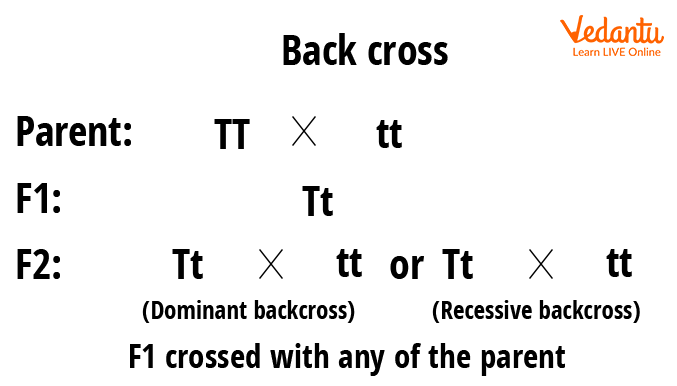Test Cross: An Introduction
A test cross is a cross between a person with an unknown genotype and another person with a homozygous recessive genotype. A test cross determines or discloses the genotype of the original person. A test cross can assist in determining if a dominant phenotype is homozygous or heterozygous for a certain trait.
Test Cross
A test cross is a genetic technique discovered by Gregor Mendel that entails mating an individual with all phenotypically recessive individuals, to ascertain the zygosity of the former by evaluating the proportions of offspring phenotypes. Zygosity can be homozygous or heterozygous. Heterozygous individuals have one dominant and one recessive allele.
Individuals with homozygous dominant alleles have two dominant alleles, whereas individuals with homozygous recessive alleles have two recessive alleles. The alleles inherited from the parents define the genotype of an offspring for each of its genes.
The allele combination is the product of the maternal and paternal chromosomes provided by each gamete during the fertilisation of that offspring. During meiosis in gametes, homologous chromosomes undergo genetic recombination and randomly separate into haploid daughter cells, each with a unique combination of maternally and paternally coded genes. Dominant alleles will overpower recessive allele expression.
The genotypic ratios may be derived using mathematical probability, but the genotypic composition cannot be determined merely by looking at the phenotype of a dominant feature. It is impossible to determine whether a tall plant from F1 or F2 has TT or Tt composition.
As a result, Mendel crossed a tall plant from F2 with a dwarf plant to identify the genotype of a tall plant at F2. It is known as a test cross. Instead of self-pollination, a dominant phenotypic organism is mated with a recessive parent in a normal test cross. The offspring of such a hybrid is simply analysed to predict the genotype of the test organism.
Test Cross Example
Let’s assume that you were handed a tall pea plant with no knowledge of its parentage. Since tallness is a dominant feature in peas, your plant may be homozygous (TT) or heterozygous (Tt), but you'd have no idea. In this case, a test cross can be used to establish its genotype.
If the plant were homozygous (TT), a test cross would produce all tall progeny (TT 🡪 tt: all Tt); if the plant were heterozygous (Tt), the test cross would produce half tall progeny and half short progeny (Tt 🡪 tt: Tt and tt).
Any recessive allele in the unknown genotype is expressed in the progeny of a test cross because it is linked with a recessive allele from the homozygous recessive parent.

Test Cross
What is Homozygous and Heterozygous?
Mendel hypothesised that the allelic pair of genes for height in a pure breeding tall or dwarf pea variety are identical. TT and tt, Bateson and Saunders referred to this situation as “homozygous.” A hybrid is an individual who has two distinct alleles (Tt). This condition was termed heterozygous by Bateson and Saunders.
Individual phenotype, DD and Dd are tall, but dd is a dwarf. When both alleles are the same (DD or dd), the individual is called a homozygote; when the alleles are different (Dd), the words heterozygous and heterozygote are used.
Homozygous Recessive
The organism with an unknown genotype that expresses the dominant phenotype is crossed with a known homozygous recessive individual.
Cross Genetics
Monohybrid Cross
A monohybrid cross is a cross between two individuals who have homozygous genotypes for the opposing phenotype for a certain genetic characteristic. Geneticists utilise monohybrid crosses to study how homozygous children express heterozygous genes acquired from their parents.
Dihybrid Cross
A dihybrid cross is a cross between two distinct genes whose observable features differ. It is the result of a cross between two heterozygous people, for two separate features.
Back Cross
Two lines are crossed to produce a hybrid in a back cross. The offspring are then selected and crossed with one of the parents. Back crosses are extremely beneficial in plant breeding because they allow breeders to hybridise a high-yielding variety with another variety to introduce the desired feature, then back cross to ensure the progeny have the same desirable qualities as the high-yielding variety.

Back Cross
Conclusion
This article covers the test cross, who discovered the test cross and various examples of it. It also stated the difference between homozygous and heterozygous. We have seen a homozygous example and a heterozygous example, and understood the difference between dominant and recessive. Also, how heterozygous recessive can’t show a trait but can become the carrier.


FAQs on Test Cross
1. What is the significance of the test cross?
The significance of the test cross:
Very important in identifying an organism's genetic composition.
Simpler and faster way of obtaining desirable characteristics in homozygous individuals.
Used to establish linkage relationships between genes.
Extremely beneficial to breeders and geneticists.
It aids in determining an organism's genetic make-up.
Used to establish linkage relationships between genes.
2. Explain the differences between monohybrid and dihybrid crosses.
A monohybrid cross occurs when two individuals have homozygous genotypes for the opposite phenotype for a certain genetic trait. A dihybrid cross is a cross between two distinct genes whose observable features differ. It is the result of a cross between two people who are heterozygous for two separate features.
The number of characteristics investigated in the offspring distinguishes a monohybrid cross from a dihybrid cross. The inheritance of a single gene is anticipated in a monohybrid cross since the parents are homozygous, however in a dihybrid cross, the parents vary in two separate features.
3. What are the disadvantages of test cross?
The disadvantages of test cross are:
It is ineffective for quantitative traits.
It is more limited in recessive traits.
In reality, portions of the genome from non-recurrent parents are frequently present and can be associated with undesirable features.
Limited recombination may keep thousands of 'foreign' genes within the elite cultivar over extremely broad crosses.
Many backcrosses are needed to create a new cultivar, which might take years.










